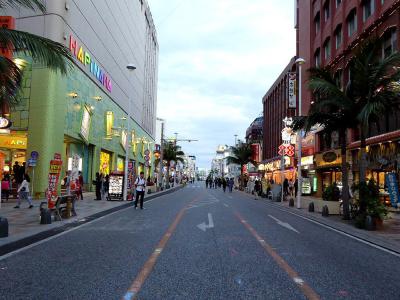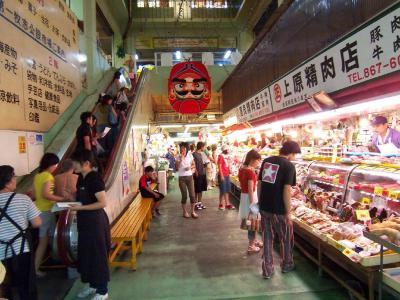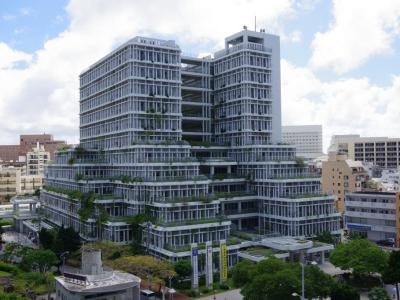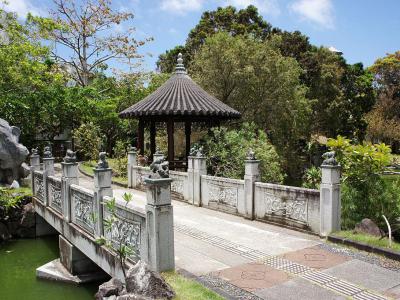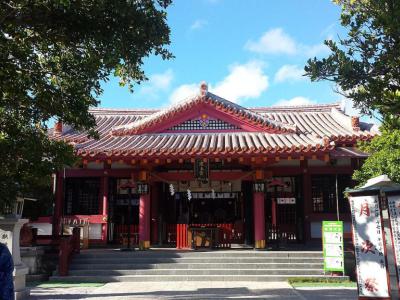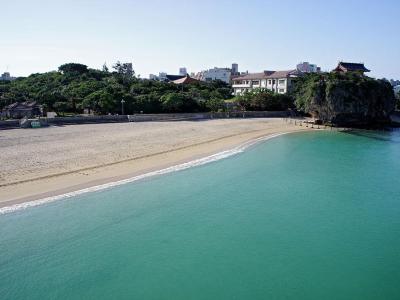Naha Introduction Walking Tour (Self Guided), Naha
Naha, the dynamic capital of Okinawa, Japan, although small a city as such, does contain a plethora of historic attractions. Recognizing it as the birthplace of Okinawa karate also adds greatly to the city's appeal among sports enthusiasts.
Naha derives its name from the word "Naba," which references a large stone shaped like a mushroom that once graced the city but over time eroded and disappeared. Similarly, throughout the centuries, the original name itself sustained changes in pronunciation and spelling.
Archaeological findings suggest Naha's active trade presence in the Japanese archipelago from as early as the 11th century. By the early 15th century, Naha evolved into a vibrant port city with bustling marketplaces, religious sites, and forts defending trade routes. Nearby, Tomari served as a vital port for inter-island trade within the Ryūkyū Islands.
Kumemura, renowned for Chinese learning, thrived as a walled community with temples and schools. Wakasamachi, a settlement founded by the Japanese, boasted shrines and facilitated trade with the Tokara Islands.
In the mid-19th century, Naha gained international attention when American Commodore Perry's squadron visited the area during his expedition to Japan. After the Ryūkyū Kingdom's replacement with the Ryūkyū Domain in 1872, Naha became the capital, further solidifying its significance.
World War II inflicted severe damage on Naha, necessitating extensive reconstruction. In 1954, Oroku village merged with the city, expanding its boundaries.
On April 1, 2013, Naha attained core city status, granting it greater autonomy in governance and public services, making it the first such city in Okinawa Prefecture.
Stepping into Naha, visitors are immediately drawn to Kokusaidori, or International Road, a bustling thoroughfare lined with shops, restaurants, and vibrant entertainment venues.
For those seeking a taste of authentic Okinawan culture, a visit to Makishi Public Market is a must. Here, visitors can sample local delicacies, shop for fresh produce and seafood, and immerse themselves in the lively atmosphere of this bustling market.
Fukushu-en Garden provides a tranquil escape from the hustle and bustle of the city, with its meticulously landscaped gardens and traditional Okinawan architecture.
For a spiritual experience, Naminoue Shrine offers a serene oasis overlooking the ocean, while Naminoue Beach beckons visitors to relax and unwind on its pristine shores.
Today, Naha continues to thrive as a vibrant hub of culture, commerce, and history, welcoming visitors to explore its rich heritage and modern amenities. Whether you're fascinated by ancient traditions or eager to experience contemporary Japan, Naha offers an unforgettable journey into the heart of Okinawa.
Naha derives its name from the word "Naba," which references a large stone shaped like a mushroom that once graced the city but over time eroded and disappeared. Similarly, throughout the centuries, the original name itself sustained changes in pronunciation and spelling.
Archaeological findings suggest Naha's active trade presence in the Japanese archipelago from as early as the 11th century. By the early 15th century, Naha evolved into a vibrant port city with bustling marketplaces, religious sites, and forts defending trade routes. Nearby, Tomari served as a vital port for inter-island trade within the Ryūkyū Islands.
Kumemura, renowned for Chinese learning, thrived as a walled community with temples and schools. Wakasamachi, a settlement founded by the Japanese, boasted shrines and facilitated trade with the Tokara Islands.
In the mid-19th century, Naha gained international attention when American Commodore Perry's squadron visited the area during his expedition to Japan. After the Ryūkyū Kingdom's replacement with the Ryūkyū Domain in 1872, Naha became the capital, further solidifying its significance.
World War II inflicted severe damage on Naha, necessitating extensive reconstruction. In 1954, Oroku village merged with the city, expanding its boundaries.
On April 1, 2013, Naha attained core city status, granting it greater autonomy in governance and public services, making it the first such city in Okinawa Prefecture.
Stepping into Naha, visitors are immediately drawn to Kokusaidori, or International Road, a bustling thoroughfare lined with shops, restaurants, and vibrant entertainment venues.
For those seeking a taste of authentic Okinawan culture, a visit to Makishi Public Market is a must. Here, visitors can sample local delicacies, shop for fresh produce and seafood, and immerse themselves in the lively atmosphere of this bustling market.
Fukushu-en Garden provides a tranquil escape from the hustle and bustle of the city, with its meticulously landscaped gardens and traditional Okinawan architecture.
For a spiritual experience, Naminoue Shrine offers a serene oasis overlooking the ocean, while Naminoue Beach beckons visitors to relax and unwind on its pristine shores.
Today, Naha continues to thrive as a vibrant hub of culture, commerce, and history, welcoming visitors to explore its rich heritage and modern amenities. Whether you're fascinated by ancient traditions or eager to experience contemporary Japan, Naha offers an unforgettable journey into the heart of Okinawa.
How it works: Download the app "GPSmyCity: Walks in 1K+ Cities" from Apple App Store or Google Play Store to your mobile phone or tablet. The app turns your mobile device into a personal tour guide and its built-in GPS navigation functions guide you from one tour stop to next. The app works offline, so no data plan is needed when traveling abroad.
Naha Introduction Walking Tour Map
Guide Name: Naha Introduction Walking Tour
Guide Location: Japan » Naha (See other walking tours in Naha)
Guide Type: Self-guided Walking Tour (Sightseeing)
# of Attractions: 9
Tour Duration: 2 Hour(s)
Travel Distance: 3.7 Km or 2.3 Miles
Author: DanaOffice
Sight(s) Featured in This Guide:
Guide Location: Japan » Naha (See other walking tours in Naha)
Guide Type: Self-guided Walking Tour (Sightseeing)
# of Attractions: 9
Tour Duration: 2 Hour(s)
Travel Distance: 3.7 Km or 2.3 Miles
Author: DanaOffice
Sight(s) Featured in This Guide:
- Kokusaidori
- Heiwadori
- Shijo Hondori
- Makishi Public Market
- Naha City Hall and Cafeteria
- Fukushu-en Garden
- Tsushima Maru Museum
- Naminoue Shrine
- Naminoue Beach
1) Kokusaidori (must see)
Kokusai dori, aptly named "International Road," is a bustling thoroughfare, extending over approximately two kilometers through the heart of downtown Naha. Its moniker derives from the historic "Ernie Pyle International Theater," a cinematic gem erected along its path in the post-war era.
As you embark on your journey along Kokusaidori, the tapestry of experiences unfolds. Commencing near the Naha Bus Terminal and the imposing Okinawa Prefectural Office, the avenue invites you to immerse yourself in a symphony of culinary delights, café culture, eclectic bars, cozy hotels, charming souvenir emporiums, fashionable boutiques, and well-established department stores.
Kokusai dori's enchantment is further illuminated by the fact that many of its establishments keep their doors open until the late hours, offering the perfect backdrop for nocturnal exploration. Harmonizing with this lively ambiance, the air resonates with the enchanting melodies of live Okinawan music, serenading patrons from several of its welcoming eateries.
For those seeking an even deeper dive into retail therapy, a kaleidoscope of vibrant, covered shopping arcades beckons. Meandering away from Kokusaidori, you'll encounter Heiwadori, Mutsumidori, and Ichiba Hondori, all branching off from Kokusaidori near the intersection with Okieidori, around the midway point of the avenue. These delightful alleyways host an array of smaller shops, often operated by passionate local entrepreneurs, offering an intimate shopping experience.
Venturing further into these charming arcades, the touristy atmosphere gradually yields to a more authentic, local vibe. Amidst the labyrinthine streets, you'll discover not only an array of bars and eateries but also clothing boutiques and hardware shops. The sensory journey takes an exotic turn as well, with fruit shops offering an array of tropical delights, including succulent pineapples, juicy mangos, and luscious passionfruit. Each establishment possesses its unique character, and their hours of operation reflect the rhythm of the locale, with some bars and eateries extending their services well into the night.
As you embark on your journey along Kokusaidori, the tapestry of experiences unfolds. Commencing near the Naha Bus Terminal and the imposing Okinawa Prefectural Office, the avenue invites you to immerse yourself in a symphony of culinary delights, café culture, eclectic bars, cozy hotels, charming souvenir emporiums, fashionable boutiques, and well-established department stores.
Kokusai dori's enchantment is further illuminated by the fact that many of its establishments keep their doors open until the late hours, offering the perfect backdrop for nocturnal exploration. Harmonizing with this lively ambiance, the air resonates with the enchanting melodies of live Okinawan music, serenading patrons from several of its welcoming eateries.
For those seeking an even deeper dive into retail therapy, a kaleidoscope of vibrant, covered shopping arcades beckons. Meandering away from Kokusaidori, you'll encounter Heiwadori, Mutsumidori, and Ichiba Hondori, all branching off from Kokusaidori near the intersection with Okieidori, around the midway point of the avenue. These delightful alleyways host an array of smaller shops, often operated by passionate local entrepreneurs, offering an intimate shopping experience.
Venturing further into these charming arcades, the touristy atmosphere gradually yields to a more authentic, local vibe. Amidst the labyrinthine streets, you'll discover not only an array of bars and eateries but also clothing boutiques and hardware shops. The sensory journey takes an exotic turn as well, with fruit shops offering an array of tropical delights, including succulent pineapples, juicy mangos, and luscious passionfruit. Each establishment possesses its unique character, and their hours of operation reflect the rhythm of the locale, with some bars and eateries extending their services well into the night.
2) Heiwadori
Heiwadori, not far from Kokusai-dori Street, is a 336-meter-long covered shopping street with around 200 shops. This place offers a range of products, including souvenirs, clothing, Okinawan snacks, and sweets. What sets it apart from Kokusai-dori Street is its more local, nostalgic vibe.
One of the attractions of Heiwadori is its affordability. You can buy souvenirs here at much lower prices compared to the airport, making it a popular spot for both tourists and locals. Plus, the covered arcade provides shelter from the rain, so you can shop comfortably even on wet days.
Conveniently located near Kokusaidori and Ichibadori, Heiwadori is a great place to stop by for shopping or a quick bite to eat. It stands out from Kokusaidori with its unique shops, offering things like freshly squeezed juice made from Okinawan fruits, kariyushi shirts similar to Hawaiian aloha shirts, Ryukyu glassware, and affordable accessories, all with a distinct Okinawan flair.
Interestingly, the name "Heiwadori" comes from the Japanese word "heiwa," meaning peace. It was chosen through a public naming contest in 1951, but it's also associated with the former Heiwakan Movie Theater that used to be at the arcade's entrance. So, whether you're a tourist or a local, Heiwadori Street offers a budget-friendly and culturally rich shopping experience worth exploring.
One of the attractions of Heiwadori is its affordability. You can buy souvenirs here at much lower prices compared to the airport, making it a popular spot for both tourists and locals. Plus, the covered arcade provides shelter from the rain, so you can shop comfortably even on wet days.
Conveniently located near Kokusaidori and Ichibadori, Heiwadori is a great place to stop by for shopping or a quick bite to eat. It stands out from Kokusaidori with its unique shops, offering things like freshly squeezed juice made from Okinawan fruits, kariyushi shirts similar to Hawaiian aloha shirts, Ryukyu glassware, and affordable accessories, all with a distinct Okinawan flair.
Interestingly, the name "Heiwadori" comes from the Japanese word "heiwa," meaning peace. It was chosen through a public naming contest in 1951, but it's also associated with the former Heiwakan Movie Theater that used to be at the arcade's entrance. So, whether you're a tourist or a local, Heiwadori Street offers a budget-friendly and culturally rich shopping experience worth exploring.
3) Shijo Hondori
Shijo Hondori has established itself as a go-to destination for bargain hunters and food enthusiasts alike. This vibrant thoroughfare offers a diverse range of shopping opportunities, from clothing and antiques to accessories and souvenirs.
What sets Shijo Hondori apart is its remarkable selection of local culinary delights. Shoppers can peruse fresh meat and vegetables, then head up to the first floor to have their purchases expertly prepared at one of the many restaurants. In addition to food, the street is dotted with charming small cafes and bakeries, offering an array of beverages, pastries, cookies, and sandwiches.
Notably, the Makishi Public Market in the vicinity is a prime spot for those seeking fresh sushi or exotic fruits. On Tuesdays, visitors can savor the unique experience of trying dragon fruit and indulging in a piping hot bowl of seafood served with noodles and flavorful broth.
The market also boasts an impressive variety of fish, some of which may be entirely unfamiliar to the uninitiated. Beyond the culinary offerings, Shijo Hondori leads shoppers to a cluster of stores specializing in ceramic items, including exquisite teapots and dinner bowls.
Before bidding farewell to this dynamic locale, don't forget to pick up a few souvenirs, and if you happen to be an antique enthusiast, consider striking a deal on fine china. Shijo Hondori promises a multifaceted shopping and culinary experience that appeals to a wide range of tastes and interests.
What sets Shijo Hondori apart is its remarkable selection of local culinary delights. Shoppers can peruse fresh meat and vegetables, then head up to the first floor to have their purchases expertly prepared at one of the many restaurants. In addition to food, the street is dotted with charming small cafes and bakeries, offering an array of beverages, pastries, cookies, and sandwiches.
Notably, the Makishi Public Market in the vicinity is a prime spot for those seeking fresh sushi or exotic fruits. On Tuesdays, visitors can savor the unique experience of trying dragon fruit and indulging in a piping hot bowl of seafood served with noodles and flavorful broth.
The market also boasts an impressive variety of fish, some of which may be entirely unfamiliar to the uninitiated. Beyond the culinary offerings, Shijo Hondori leads shoppers to a cluster of stores specializing in ceramic items, including exquisite teapots and dinner bowls.
Before bidding farewell to this dynamic locale, don't forget to pick up a few souvenirs, and if you happen to be an antique enthusiast, consider striking a deal on fine china. Shijo Hondori promises a multifaceted shopping and culinary experience that appeals to a wide range of tastes and interests.
4) Makishi Public Market (must see)
The Naha Public Market serves as a veritable window into the everyday life of Okinawa, offering a cornucopia of produce, meat, fish, and general merchandise. The market's first floor is an eclectic showcase of Okinawan culinary delights, featuring an array of offerings that span from succulent pork, including unconventional parts like pig's face, feet, and stomach, to a kaleidoscope of colorful fish and shellfish, exotic vegetables such as goya (bitter melon) and hechima (sponge gourd), and tropical fruits sourced directly from nearby farms. As you navigate this gastronomic haven, the small alleys that intertwine with the market beckon with stand-up-style shops, tempting visitors with fresh tempura, steamed cakes, and invigorating goya juice.
For those craving an immersive dining experience, the market's second floor is home to an ensemble of eateries that cater to every palate. Here, you can savor an extensive range of Okinawan delicacies at affordable prices within a food court-style setting, allowing you to order diverse dishes from different restaurants under one roof.
Makishi Public Market is not merely a place to satiate one's culinary desires but also an avenue to foster connections with the local community. The ethos of "ichariba chode," an Okinawan spirit that translates to "once we meet, we are like brothers and sisters," pervades the marketplace.
For those craving an immersive dining experience, the market's second floor is home to an ensemble of eateries that cater to every palate. Here, you can savor an extensive range of Okinawan delicacies at affordable prices within a food court-style setting, allowing you to order diverse dishes from different restaurants under one roof.
Makishi Public Market is not merely a place to satiate one's culinary desires but also an avenue to foster connections with the local community. The ethos of "ichariba chode," an Okinawan spirit that translates to "once we meet, we are like brothers and sisters," pervades the marketplace.
5) Naha City Hall and Cafeteria
Naha City Hall stands out not only for its administrative functions but also for its remarkable architecture. Its unique exterior design, adorned with abundant greenery, immediately catches the eye of passersby. Located in close proximity to the bustling Kokusai-dori, the city hall serves as a focal point in the urban landscape, drawing visitors with its intriguing aesthetics.
Within the confines of this distinctive structure lies a hidden gem-a cafeteria nestled on the second floor. As patrons ascend, they are greeted with an extensive menu offering a plethora of tempting choices. However, what sets this dining experience apart is its emphasis on health-conscious cuisine. The flavors are delicate and mild, reflecting a consideration for well-being without compromising on taste.
To streamline the ordering process, a convenient ticket machine at the entrance allows patrons to purchase meal tickets, facilitating a self-service dining experience. Set meals, renowned for their deliciousness, are the highlight of the menu, showcasing the best of Okinawan cuisine.
Despite its central location, the cafeteria manages to offer an authentic taste of Okinawan fare without the inflated prices often associated with tourist-centric dining spots.
Within the confines of this distinctive structure lies a hidden gem-a cafeteria nestled on the second floor. As patrons ascend, they are greeted with an extensive menu offering a plethora of tempting choices. However, what sets this dining experience apart is its emphasis on health-conscious cuisine. The flavors are delicate and mild, reflecting a consideration for well-being without compromising on taste.
To streamline the ordering process, a convenient ticket machine at the entrance allows patrons to purchase meal tickets, facilitating a self-service dining experience. Set meals, renowned for their deliciousness, are the highlight of the menu, showcasing the best of Okinawan cuisine.
Despite its central location, the cafeteria manages to offer an authentic taste of Okinawan fare without the inflated prices often associated with tourist-centric dining spots.
6) Fukushu-en Garden (must see)
Fukushu-en Garden is a testament to the enduring friendship between Naha and its sister city, Fuzhou in China. Established in 1992 to commemorate a decade of partnership, this enchanting park is a celebration of Chinese culture and nature, offering visitors a glimpse into the beauty of Fuzhou's landscapes. Much of the wood and stone adorning Fukushu-en were sourced directly from Fuzhou, infusing the space with an authentic essence of Chinese craftsmanship and tradition.
At the heart of Fukushu-en lies a picturesque lake, teeming with koi carp and turtles, which meanders gracefully throughout the grounds. Divided into sections representing the beauty of each season, the garden offers visitors a sensory journey through spring blossoms, summer greenery, and the vibrant hues of autumn and winter foliage.
Inspired by the principles of traditional Chinese garden design, Fukushu-en showcases elements such as borrowed scenery, striking rock formations, and a captivating waterfall that cascades serenely amidst the lush greenery. Visitors can marvel at the intricately designed pagodas, graceful bridges, and ornate pavilions that adorn the landscape, each structure imbued with cultural significance and architectural elegance.
At the heart of Fukushu-en lies a picturesque lake, teeming with koi carp and turtles, which meanders gracefully throughout the grounds. Divided into sections representing the beauty of each season, the garden offers visitors a sensory journey through spring blossoms, summer greenery, and the vibrant hues of autumn and winter foliage.
Inspired by the principles of traditional Chinese garden design, Fukushu-en showcases elements such as borrowed scenery, striking rock formations, and a captivating waterfall that cascades serenely amidst the lush greenery. Visitors can marvel at the intricately designed pagodas, graceful bridges, and ornate pavilions that adorn the landscape, each structure imbued with cultural significance and architectural elegance.
7) Tsushima Maru Museum
The Tsushima Maru Museum stands as a poignant reminder of one of the most tragic events of World War II. The Tsushima Maru, a Japanese passenger and cargo ship, met its fate on August 22, 1944, when it was struck by torpedoes from the submarine USS Bowfin. The ship, carrying hundreds of schoolchildren from Okinawa to Kagoshima, sank close to the island of Akusekijima. The devastating attack resulted in the loss of 1,484 civilians, including 767 innocent schoolchildren, leaving only 59 survivors to tell the harrowing tale.
In honor of the victims of this tragic event, a museum was established to commemorate their lives and preserve their memory. Visitors to the museum can pay their respects and learn about the individuals who perished and those who survived through displays showcasing photographs, personal belongings, and a replica of the ship. These artifacts serve as powerful reminders of the human toll of war and the importance of remembering the past to ensure such tragedies are never repeated.
Adjacent to the museum lies Asahigaoka Park, a serene sanctuary housing various memorials dedicated to the victims of the Tsushima Maru sinking and other wartime atrocities. From the park's Kozakura Tower, visitors can behold the port from which the Tsushima Maru embarked on its final journey. Among the park's landmarks are the Naminoue Shrine and Gokoku Temple, revered sites that provide solace and spiritual contemplation amidst the tranquil surroundings.
As visitors explore Asahigaoka Park, they encounter a multitude of memorial monuments, each serving as a testament to the resilience and enduring spirit of those affected by the war. From the Statue of Uminari, honoring the shipwreck victims of the Battle of Okinawa, to the Kozakura Tower, dedicated to the souls lost aboard the Tsushima Maru, these monuments stand as silent sentinels, ensuring that the sacrifices of the past are never forgotten.
In honor of the victims of this tragic event, a museum was established to commemorate their lives and preserve their memory. Visitors to the museum can pay their respects and learn about the individuals who perished and those who survived through displays showcasing photographs, personal belongings, and a replica of the ship. These artifacts serve as powerful reminders of the human toll of war and the importance of remembering the past to ensure such tragedies are never repeated.
Adjacent to the museum lies Asahigaoka Park, a serene sanctuary housing various memorials dedicated to the victims of the Tsushima Maru sinking and other wartime atrocities. From the park's Kozakura Tower, visitors can behold the port from which the Tsushima Maru embarked on its final journey. Among the park's landmarks are the Naminoue Shrine and Gokoku Temple, revered sites that provide solace and spiritual contemplation amidst the tranquil surroundings.
As visitors explore Asahigaoka Park, they encounter a multitude of memorial monuments, each serving as a testament to the resilience and enduring spirit of those affected by the war. From the Statue of Uminari, honoring the shipwreck victims of the Battle of Okinawa, to the Kozakura Tower, dedicated to the souls lost aboard the Tsushima Maru, these monuments stand as silent sentinels, ensuring that the sacrifices of the past are never forgotten.
8) Naminoue Shrine (must see)
Naminoue Shrine, meaning "Above the Waves Shrine," stands as a sacred bastion of Shinto spirituality in Naha. Perched atop a lofty bluff, the shrine commands a breathtaking view of Naminoue Beach and the vast expanse of the ocean beyond. Originally revered as a sacred site in the indigenous Ryukyuan religion, Naminoue Shrine was dedicated to nirai kanai, the mythical source of all life, and to the boundless power of the sea.
Legend has it that the shrine's origins trace back to a humble fisherman who, through divine intervention, discovered a mystical stone while fishing near the shore. As the fisherman offered prayers to the stone, his catches miraculously improved, imbuing the stone with a radiant glow. However, the gods reclaimed the stone, leaving behind an oracle in its place. This mystical event led to the shrine's establishment, eventually becoming a beacon of spiritual protection and maritime safety for sailors navigating the waters surrounding Naha's bustling port.
Throughout its storied history, Naminoue Shrine evolved into a revered sanctuary, playing a pivotal role in the spiritual and ceremonial life of the Ryukyu Kingdom. Each year, the king paid homage to the shrine, offering prayers for bountiful harvests, prosperous fishing, and the enduring peace and prosperity of the nation. Designated as the guardian shrine for the tranquility of Okinawa, it continues to serve as a sacred sanctuary where worshippers seek blessings for safe journeys, abundant harvests, and the well-being of the community.
Legend has it that the shrine's origins trace back to a humble fisherman who, through divine intervention, discovered a mystical stone while fishing near the shore. As the fisherman offered prayers to the stone, his catches miraculously improved, imbuing the stone with a radiant glow. However, the gods reclaimed the stone, leaving behind an oracle in its place. This mystical event led to the shrine's establishment, eventually becoming a beacon of spiritual protection and maritime safety for sailors navigating the waters surrounding Naha's bustling port.
Throughout its storied history, Naminoue Shrine evolved into a revered sanctuary, playing a pivotal role in the spiritual and ceremonial life of the Ryukyu Kingdom. Each year, the king paid homage to the shrine, offering prayers for bountiful harvests, prosperous fishing, and the enduring peace and prosperity of the nation. Designated as the guardian shrine for the tranquility of Okinawa, it continues to serve as a sacred sanctuary where worshippers seek blessings for safe journeys, abundant harvests, and the well-being of the community.
9) Naminoue Beach
Naminoue Beach stands out due to its unique feature-a highway that runs straight across the sea right in front of it. Despite this unusual characteristic, the beach remains a popular destination for both locals and tourists alike. It is the sole beach in Naha where swimming is allowed, making it a convenient choice for those staying nearby or on a short stopover in the city.
What sets Naminoue Beach apart is not just its proximity to the highway, but also its cleanliness. The sand and the sea here are well-maintained. The waters are shallow and sheltered, making them suitable for swimmers of all ages and skill levels, thanks to the mild currents. If you're lucky, you might even catch a glimpse of people snorkeling in the area.
Situated within walking distance of Kokusai Dori, Naha Fukushuen, and various other city attractions, Naminoue Beach provides the perfect respite during a busy day of sightseeing. Facilities like changing rooms, toilets, and paid showers are available, and there are also small shops lining the seafront for your convenience.
Overlooking the beach from a low cliff is Naminoue Shrine, often referred to as "the shrine above the waves." As the primary Shinto shrine in Okinawa, it's a worthwhile visit, especially during the Nanmin Festival held in May.
Naminoue Beach offers free admission, and from April to October, you can rent items such as deck chairs and parasols, as well as take advantage of barbecue facilities for an enjoyable day by the sea.
What sets Naminoue Beach apart is not just its proximity to the highway, but also its cleanliness. The sand and the sea here are well-maintained. The waters are shallow and sheltered, making them suitable for swimmers of all ages and skill levels, thanks to the mild currents. If you're lucky, you might even catch a glimpse of people snorkeling in the area.
Situated within walking distance of Kokusai Dori, Naha Fukushuen, and various other city attractions, Naminoue Beach provides the perfect respite during a busy day of sightseeing. Facilities like changing rooms, toilets, and paid showers are available, and there are also small shops lining the seafront for your convenience.
Overlooking the beach from a low cliff is Naminoue Shrine, often referred to as "the shrine above the waves." As the primary Shinto shrine in Okinawa, it's a worthwhile visit, especially during the Nanmin Festival held in May.
Naminoue Beach offers free admission, and from April to October, you can rent items such as deck chairs and parasols, as well as take advantage of barbecue facilities for an enjoyable day by the sea.
Walking Tours in Naha, Japan
Create Your Own Walk in Naha
Creating your own self-guided walk in Naha is easy and fun. Choose the city attractions that you want to see and a walk route map will be created just for you. You can even set your hotel as the start point of the walk.
Shuri District Walking Tour
Once an independent city and the esteemed royal capital of the Ryūkyū Kingdom, Shuri has been a district in the city of Naha since 1954. Originally established as a castle town surrounding the royal palace, Shuri's status as the capital ceased with the dissolution of the kingdom and its incorporation into Japan as part of Okinawa prefecture. Renowned for its historical significance, today... view more
Tour Duration: 2 Hour(s)
Travel Distance: 3.8 Km or 2.4 Miles
Tour Duration: 2 Hour(s)
Travel Distance: 3.8 Km or 2.4 Miles
The Most Popular Cities
/ view all



